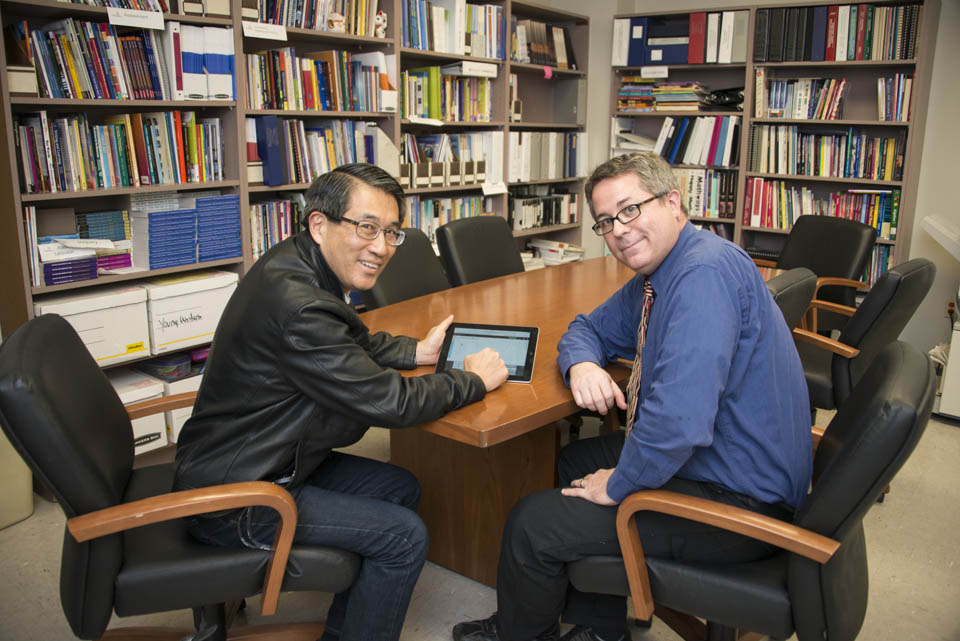Changing the Way We Teach: Education Professor Receives Grant for Investing in Innovation
It’s taken five years of writing lengthy appeals to the United States Department of Education (USDE), countless hours of constructing a high-profile research model, and numerous attempts at creating an innovative teaching method combined with a highly technological approach, but secondary education professor Ivan Cheng finally reached his goal.
With a $3.6 million grant titled “i3 Investing in Innovation” from the USDE, Cheng and his team of collaborators at California State University, Northridge – Andy Ainsworth is the associate director of the CSUN Center for Assessment, Research and Evaluation (CARE) and will be working as the lead evaluator on the i3 grant – can now start their work on a breakthrough method of teaching Common Core Standards mathematics to K-12 students and their teachers that combines technology with collaborative teaching. Helping them is Silicon Valley-based software firm LearningTech.
The idea for the project was inspired by the adoption of the new Common Core standards in 2010, which changed the way mathematics is taught in schools, from the structure of the textbooks to their content.
“The premise is that most teachers in mathematics are not adequately prepared to implement the new standards that have now been adopted by 43 states,” Cheng said. “The way that mathematics is taught historically is not aligned with the common core standards. So, when the standards were first adopted in 2010, teachers were left to fend for themselves. They were in the dark without adequate support.”
Cheng said his project would help instructors teach mathematics more effectively by creatively using a tablet app and a collaborative approach to teaching. This is in sharp contrast to the traditional method, which involves going through each chapter of a textbook that may no longer be aligned with the new standards.
“Many teachers are enslaved to their textbooks,” he said. “They put a lot of trust in the textbook as the ultimate guide for teaching the content. But no textbook alone can address the diverse needs of all students. As a result, many students fail. That failure has disastrous consequences, particularly for students of color.”
According to nationsreportcard.gov, eighth-grade African-American students scored a national average of 263, Latino students scored 272 and whites scored 294, more than 30 points above African-American students and more than 20 points above Latino students.
Cheng said he and his team hope to change mathematic teaching for the better.
“Our hypothesis is that not only will teachers become more effective in teaching their kids, they will also deepen their own knowledge of how kids learn and how mathematics could be taught, and even the content of mathematics,” Cheng said. “As teachers think through the math and how to teach it, they are no longer just blindly trusting the textbook. As a teacher thinks through what kids need to know, they are now thinking at a higher level of mathematics themselves.”
Cheng’s new approach consists of two parts: a collaborative teaching cohort approach where teachers will meet to discuss how to create lesson activities for their students; and a tablet app, currently titled the “Discovery Learning App,” that will be flexible in creating lesson activities that teachers may use with their students in the classroom.
“The app is designed to help teachers rapidly set up some kind of mathematical activity that requires kids to use their critical thinking skills and to take advantage of what technology offers, which is dynamic interactive activities,” he said.
Cheng explained the app uses various forms of expressing mathematic concepts. For example, with an equation, the app may develop a graph of the equation as well as a verbal expression of the problem.
“If you change one part of the equation, the other parts change with it,” Cheng said. “Or the teacher can unlink them to the students, so only the teacher can see everything. The student has to figure out what the graph should be aligned with the equation.”
While apps like his already exist, Cheng said the new teaching model, called the Responsive Teaching Cycle (RTC), will allow teachers to collaborate on how to use the app to be more effective in the classroom.
“While there are apps out there, what’s not out there is combining those features with a lesson activity” Cheng said. “Traditionally, you can go to an iPad and look at the app, but there is no lesson. Now it’s all in one place.
“It will be transformative for the teachers. It’s going to break down the silos and the individualistic mentality and foster a more collaborative environment. Teachers are going to have to talk to each other over lesson activities. The app will make it so quick and easy that they won’t need to have tremendous computer skills to create great lesson activities and assessments.”
Cheng and his colleagues will begin testing the new teaching method this month with 100 instructors from Los Angeles Unified School District, Burbank Unified School District and Ventura Unified School District, along with their eighth grade students. Subtracting 10 teachers who will use the beta version of the app in the first year, 90 teachers will be split in two groups, one being the control the other being the treatment group. The effectiveness of the teaching method will be compared to the control group by looking at the standardized test scores of the students.
Cheng said he and his team have high hopes for the success of the method.
“Hand in hand, we believe that this combination is going to help teachers be much more successful than teachers who don’t have it,” he said. “The new way of teaching is much more realistic to what life is like, to what life throws at us. There is no answer key in life. My biggest hope is that we can transform how teachers teach kids. That’s hands down what I want to do.”


 experience
experience